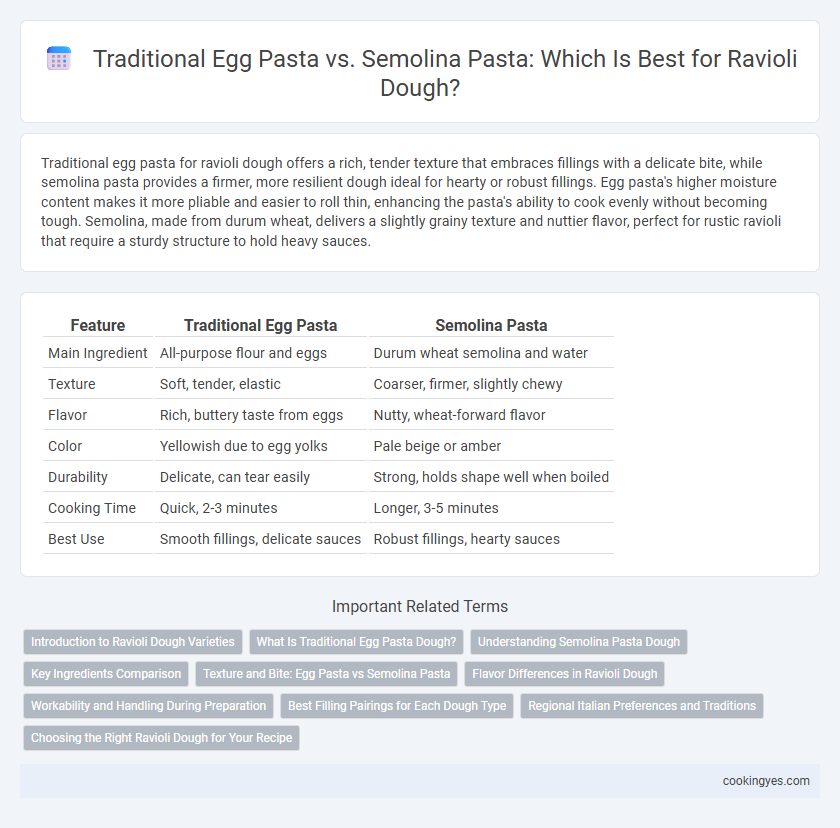Traditional egg pasta for ravioli dough offers a rich, tender texture that embraces fillings with a delicate bite, while semolina pasta provides a firmer, more resilient dough ideal for hearty or robust fillings. Egg pasta's higher moisture content makes it more pliable and easier to roll thin, enhancing the pasta's ability to cook evenly without becoming tough. Semolina, made from durum wheat, delivers a slightly grainy texture and nuttier flavor, perfect for rustic ravioli that require a sturdy structure to hold heavy sauces.
Table of Comparison
| Feature | Traditional Egg Pasta | Semolina Pasta |
|---|---|---|
| Main Ingredient | All-purpose flour and eggs | Durum wheat semolina and water |
| Texture | Soft, tender, elastic | Coarser, firmer, slightly chewy |
| Flavor | Rich, buttery taste from eggs | Nutty, wheat-forward flavor |
| Color | Yellowish due to egg yolks | Pale beige or amber |
| Durability | Delicate, can tear easily | Strong, holds shape well when boiled |
| Cooking Time | Quick, 2-3 minutes | Longer, 3-5 minutes |
| Best Use | Smooth fillings, delicate sauces | Robust fillings, hearty sauces |
Introduction to Ravioli Dough Varieties
Traditional egg pasta for ravioli dough offers a rich, tender texture due to the combination of wheat flour and whole eggs, resulting in a delicate bite and vibrant yellow color. Semolina pasta, made from durum wheat semolina flour and water, delivers a firmer, slightly chewy consistency ideal for holding robust fillings and resisting overcooking. Choosing between egg-based and semolina dough varieties impacts the ravioli's texture, flavor absorption, and overall cooking performance.
What Is Traditional Egg Pasta Dough?
Traditional egg pasta dough for ravioli is made primarily from a mixture of all-purpose flour and whole eggs, creating a rich, pliable dough that offers a smooth texture and enhanced flavor. This dough type is favored in Italian cuisine for its elasticity and ability to hold fillings securely without breaking during cooking. Compared to semolina pasta, egg pasta dough results in a tender yet firm bite, ideal for delicate ravioli varieties.
Understanding Semolina Pasta Dough
Semolina pasta dough, made from durum wheat, offers a firm texture and excellent elasticity, making it ideal for ravioli that holds fillings without tearing. This type of dough has a higher protein content than traditional egg pasta, resulting in a chewier bite and enhanced structural integrity during cooking. Semolina's granular texture allows for better absorption of sauces, providing a rich and satisfying dining experience.
Key Ingredients Comparison
Traditional egg pasta for ravioli dough features a rich combination of wheat flour and whole eggs, providing elasticity and a tender texture ideal for delicate fillings. Semolina pasta, made primarily from semolina flour derived from durum wheat and water, offers a firmer, slightly coarser dough that holds shape well under cooking and delivers a distinct bite. Key ingredient differences impact dough elasticity, flavor, and cooking resilience, influencing ravioli texture and overall mouthfeel.
Texture and Bite: Egg Pasta vs Semolina Pasta
Traditional egg pasta for ravioli dough offers a tender, pliable texture with a smooth bite, ideal for capturing delicate fillings. Semolina pasta, made from durum wheat, provides a firmer, slightly grainier texture and a chewier bite that holds up well to robust, hearty fillings. The choice between egg and semolina pasta fundamentally influences the ravioli's mouthfeel and overall dining experience.
Flavor Differences in Ravioli Dough
Traditional egg pasta dough for ravioli offers a rich, buttery flavor and a tender texture that complements delicate fillings, enhancing the overall taste experience. Semolina pasta dough delivers a firmer bite and a slightly nutty flavor, which stands up well to robust or hearty fillings. The choice between egg and semolina dough significantly impacts the flavor profile, with egg dough providing a smoother, creamier base and semolina adding a rustic, textured character.
Workability and Handling During Preparation
Traditional egg pasta dough offers a smooth, pliable texture that enhances workability and allows for easy rolling and shaping when making ravioli. Semolina pasta dough tends to be firmer and slightly coarse, requiring more water and effort to achieve elasticity but providing a durable structure that holds fillings well. Chefs often prefer egg pasta for its softness and ease of handling, while semolina dough excels in maintaining shape during cooking without becoming overly delicate.
Best Filling Pairings for Each Dough Type
Traditional egg pasta dough for ravioli boasts a tender, elastic texture perfect for delicate fillings like ricotta and spinach or mushroom blends, enhancing their creamy and earthy flavors. Semolina pasta, with its coarser texture and firmer bite, pairs well with robust fillings such as sausage, roasted butternut squash, or beef ragu, providing a sturdy vessel that complements hearty tastes. Choosing the dough type based on the filling's texture and intensity maximizes flavor harmony and overall ravioli enjoyment.
Regional Italian Preferences and Traditions
Traditional egg pasta for ravioli, prevalent in northern Italian regions like Emilia-Romagna, offers a rich, elastic texture ideal for delicate fillings. In contrast, semolina pasta, favored in southern areas such as Campania, provides a firmer, slightly grainy dough that holds up well to heartier ingredients. These regional variations reflect centuries-old culinary traditions, influencing the taste and preparation of authentic ravioli across Italy.
Choosing the Right Ravioli Dough for Your Recipe
Traditional egg pasta for ravioli dough offers a rich texture and elasticity ideal for delicate fillings, made from durum wheat flour and whole eggs, creating a tender yet sturdy base. Semolina pasta, crafted from coarse durum wheat flour and water, provides a firmer, slightly gritty texture that holds up well to hearty, robust fillings and hearty sauces. Selecting the right dough depends on the filling's moisture content and the desired texture, with egg pasta preferred for silky, fine fillings and semolina dough for rustic, textured combinations.
Traditional egg pasta vs semolina pasta for ravioli dough Infographic

 cookingyes.com
cookingyes.com